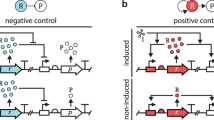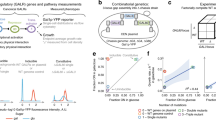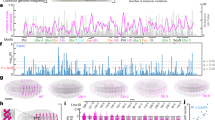Abstract
Epistasis—the non-additive interactions between different genetic loci—constrains evolutionary pathways, blocking some and permitting others1,2,3,4,5,6,7,8. For biological networks such as transcription circuits, the nature of these constraints and their consequences are largely unknown. Here we describe the evolutionary pathways of a transcription network that controls the response to mating pheromone in yeast9. A component of this network, the transcription regulator Ste12, has evolved two different modes of binding to a set of its target genes. In one group of species, Ste12 binds to specific DNA binding sites, while in another lineage it occupies DNA indirectly, relying on a second transcription regulator to recognize DNA. We show, through the construction of various possible evolutionary intermediates, that evolution of the direct mode of DNA binding was not directly accessible to the ancestor. Instead, it was contingent on a lineage-specific change to an overlapping transcription network with a different function, the specification of cell type. These results show that analysing and predicting the evolution of cis-regulatory regions requires an understanding of their positions in overlapping networks, as this placement constrains the available evolutionary pathways.
This is a preview of subscription content, access via your institution
Access options
Subscribe to this journal
Receive 51 print issues and online access
$199.00 per year
only $3.90 per issue
Buy this article
- Purchase on Springer Link
- Instant access to full article PDF
Prices may be subject to local taxes which are calculated during checkout





Similar content being viewed by others
References
Blount, Z. D., Borland, C. Z. & Lenski, R. E. Historical contingency and the evolution of a key innovation in an experimental population of Escherichia coli. Proc. Natl Acad. Sci. USA 105, 7899–7906 (2008)
Harms, M. J. & Thornton, J. W. Historical contingency and its biophysical basis in glucocorticoid receptor evolution. Nature 512, 203–207 (2014)
Mohrig, J. R. et al. Importance of historical contingency in the stereochemistry of hydratase-dehydratase enzymes. Science 269, 527–529 (1995)
Harms, M. J. & Thornton, J. W. Evolutionary biochemistry: revealing the historical and physical causes of protein properties. Nature Rev. Genet. 14, 559–571 (2013)
Ortlund, E. A., Bridgham, J. T., Redinbo, M. R. & Thornton, J. W. Crystal structure of an ancient protein: evolution by conformational epistasis. Science 317, 1544–1548 (2007)
Bershtein, S., Segal, M., Bekerman, R., Tokuriki, N. & Tawfik, D. S. Robustness-epistasis link shapes the fitness landscape of a randomly drifting protein. Nature 444, 929–932 (2006)
Bloom, J. D., Labthavikul, S. T., Otey, C. R. & Arnold, F. H. Protein stability promotes evolvability. Proc. Natl Acad. Sci. USA 103, 5869–5874 (2006)
Gerke, J., Lorenz, K. & Cohen, B. Genetic interactions between transcription factors cause natural variation in yeast. Science 323, 498–501 (2009)
Ren, B. et al. Genome-wide location and function of DNA binding proteins. Science 290, 2306–2309 (2000)
Payne, J. L. & Wagner, A. Constraint and contingency in multifunctional gene regulatory circuits. PLOS Comput. Biol. 9, e1003071 (2013)
Dolan, J. W., Kirkman, C. & Fields, S. The yeast STE12 protein binds to the DNA sequence mediating pheromone induction. Proc. Natl Acad. Sci. USA 86, 5703–5707 (1989)
Herskowitz, I. MAP kinase pathways in yeast: for mating and more. Cell 80, 187–197 (1995)
Coria, R. et al. The pheromone response pathway of Kluyveromyces lactis. FEMS Yeast Res. 6, 336–344 (2006)
Kensche, P. R., Oti, M., Dutilh, B. E. & Huynen, M. A. Conservation of divergent transcription in fungi. Trends Genet. 24, 207–211 (2008)
Bennett, R. J., Uhl, M. A., Miller, M. G. & Johnson, A. D. Identification and characterization of a Candida albicans mating pheromone. Mol. Cell. Biol. 23, 8189–8201 (2003)
Tsong, A. E., Tuch, B. B., Li, H. & Johnson, A. D. Evolution of alternative transcriptional circuits with identical logic. Nature 443, 415–420 (2006)
Herskowitz, I. A regulatory hierarchy for cell specialization in yeast. Nature 342, 749–757 (1989)
Borneman, A. R. et al. Divergence of transcription factor binding sites across related yeast species. Science 317, 815–819 (2007)
Ramos, A. I. & Barolo, S. Low-affinity transcription factor binding sites shape morphogen responses and enhancer evolution. Phil. Trans. R. Soc. Lond. B 368, 20130018 (2013)
Crocker, J. et al. Low affinity binding site clusters confer Hox specificity and regulatory robustness. Cell 160, 191–203 (2015)
Tsong, A. E., Miller, M. G., Raisner, R. M. & Johnson, A. D. Evolution of a combinatorial transcriptional circuit: a case study in yeasts. Cell 115, 389–399 (2003)
Tuch, B. B., Galgoczy, D. J., Hernday, A. D., Li, H. & Johnson, A. D. The evolution of combinatorial gene regulation in fungi. PLoS Biol. 6, e38 (2008)
Baker, C. R., Booth, L. N., Sorrells, T. R. & Johnson, A. D. Protein modularity, cooperative binding, and hybrid regulatory states underlie transcriptional network diversification. Cell 151, 80–95 (2012)
Strathern, J., Hicks, J. & Herskowitz, I. Control of cell type in yeast by the mating type locus. The α1-α2 hypothesis. J. Mol. Biol. 147, 357–372 (1981)
Galgoczy, D. J. et al. Genomic dissection of the cell-type-specification circuit in Saccharomyces cerevisiae. Proc. Natl Acad. Sci. USA 101, 18069–18074 (2004)
Wray, G. A. et al. The evolution of transcriptional regulation in eukaryotes. Mol. Biol. Evol. 20, 1377–1419 (2003)
Otto, W. et al. Measuring transcription factor-binding site turnover: a maximum likelihood approach using phylogenies. Genome Biol. Evol. 1, 85–98 (2009)
Hubisz, M. J., Pollard, K. S. & Siepel, A. PHAST and RPHAST: phylogenetic analysis with space/time models. Brief. Bioinform. 12, 41–51 (2011)
Hare, E. E., Peterson, B. K., Iyer, V. N., Meier, R. & Eisen, M. B. Sepsid even-skipped enhancers are functionally conserved in Drosophila despite lack of sequence conservation. PLoS Genet. 4, e1000106 (2008)
Swanson, C. I., Schwimmer, D. B. & Barolo, S. Rapid evolutionary rewiring of a structurally constrained eye enhancer. Curr. Biol. 21, 1186–1196 (2011)
Tirosh, I., Weinberger, A., Bezalel, D., Kaganovich, M. & Barkai, N. On the relation between promoter divergence and gene expression evolution. Mol. Syst. Biol. 4, 159 (2008)
Wapinski, I., Pfeffer, A., Friedman, N. & Regev, A. Natural history and evolutionary principles of gene duplication in fungi. Nature 449, 54–61 (2007)
Gordon, J. L. et al. Evolutionary erosion of yeast sex chromosomes by mating-type switching accidents. Proc. Natl Acad. Sci. USA 108, 20024–20029 (2011)
Lusk, R. W. & Eisen, M. B. Spatial promoter recognition signatures may enhance transcription factor specificity in yeast. PLoS ONE 8, e53778 (2013)
D'haeseleer, P. What are DNA sequence motifs? Nature Biotechnol. 24, 423–425 (2006)
Wach, A. PCR-synthesis of marker cassettes with long flanking homology regions for gene disruptions in S. cerevisiae. Yeast 12, 259–265 (1996)
Cormack, B. P. et al. Yeast-enhanced green fluorescent protein (yEGFP): a reporter of gene expression in Candida albicans. Microbiology 143, 303–311 (1997)
Tagwerker, C. et al. HB tag modules for PCR-based gene tagging and tandem affinity purification in Saccharomyces cerevisiae. Yeast 23, 623–632 (2006)
Kooistra, R., Hooykaas, P. J. J. & Steensma, H. Y. Efficient gene targeting in Kluyveromyces lactis. Yeast 21, 781–792 (2004)
Gojkovic, Z., Jahnke, K., Schnackerz, K. D. & Piskur, J. PYD2 encodes 5,6-dihydropyrimidine amidohydrolase, which participates in a novel fungal catabolic pathway. J. Mol. Biol. 295, 1073–1087 (2000)
Mitrovich, Q. M., Tuch, B. B., Guthrie, C. & Johnson, A. D. Computational and experimental approaches double the number of known introns in the pathogenic yeast Candida albicans. Genome Res. 17, 492–502 (2007)
Booth, L. N., Tuch, B. B. & Johnson, A. D. Intercalation of a new tier of transcription regulation into an ancient circuit. Nature 468, 959–963 (2010)
Borneman, A. R. et al. Target hub proteins serve as master regulators of development in yeast. Genes Dev. 20, 435–448 (2006)
Langmead, B. & Salzberg, S. L. Fast gapped-read alignment with Bowtie 2. Nature Methods 9, 357–359 (2012)
Li, H. et al. The Sequence Alignment/Map format and SAMtools. Bioinformatics 25, 2078–2079 (2009)
Zhang, Y. et al. Model-based analysis of ChIP-Seq (MACS). Genome Biol. 9, R137 (2008)
Homann, O. R. & Johnson, A. D. MochiView: versatile software for genome browsing and DNA motif analysis. BMC Biol. 8, 49 (2010)
Edgar, R. C. MUSCLE: multiple sequence alignment with high accuracy and high throughput. Nucleic Acids Res. 32, 1792–1797 (2004)
Posada, D. & Crandall, K. A. Selecting models of nucleotide substitution: an application to human immunodeficiency virus 1 (HIV-1). Mol. Biol. Evol. 18, 897–906 (2001)
Acknowledgements
We thank S. Coyle, I. Nocedal, C. Dalal, C. Britton, C. Baker, and V. Hanson-Smith for valuable comments on the manuscript. We also thank K. Pollard, E. Mancera, C. Nobile, and Q. Mitrovich for advice and assistance with experiments and analysis. We thank K. Boundy-Mills of the Phaff Yeast Culture Collection, University of California, Davis for the K. lactis isolates. The work was supported by grant R01 GM037049 from the National Institutes of Health. T.R.S. was supported by a Graduate Research Fellowship from the National Science Foundation.
Author information
Authors and Affiliations
Contributions
T.R.S. performed gene expression experiments, reporter assays, ChIP-Seq, and bioinformatics analyses. L.N.B. obtained and sequenced the asg promoters of the K. lactis isolates. B.B.T. conceived of, designed, and performed a preliminary analysis of the phylogenetic distribution of Ste12 sites across the asgs. T.R.S., L.N.B., and A.D.J. designed and interpreted experiments and edited the manuscript. T.R.S. and A.D.J. wrote the manuscript.
Corresponding author
Ethics declarations
Competing interests
The authors declare no competing financial interests.
Extended data figures and tables
Extended Data Figure 1 Conservation of Ste12 function.
Expression of the asg STE2 and the general pheromone-activated gene FUS3 in the presence of K. lactis Ste12, in the absence of Ste12, and in the presence of S. cerevisiae Ste12. Expression under uninduced and pheromone-induced conditions are shown as mean fluorescence ±s.d. of three independent genetic isolates, grown and analysed separately.
Extended Data Figure 2 Distribution of Ste12 cis-regulatory sites.
Individual a-specific genes and general pheromone-activated genes were scored for the presence of Ste12 cis-regulatory motifs in their upstream regulatory regions. Shown is the number of consensus Ste12 sites within 600 bp of the translation start site. Orthologues that could not be identified in a given species are shown in grey. The enrichment for the Ste12 motif in each set of genes in each species is shown in Fig. 1c.
Extended Data Figure 3 Distribution of mismatched Ste12 cis-regulatory sites.
asgs were scored for the presence of mismatched Ste12 binding sites in their upstream regulatory regions. The enrichment of the Ste12 site in the asgs in each species is shown in the bottom row.
Extended Data Figure 4 Ste12 sites are required in S. cerevisiae asgs.
The S. cerevisiae STE2 promoter was fused to GFP and the role of Ste12 cis-regulatory sites in expression. Expression under uninduced and pheromone-induced conditions are shown as mean fluorescence ±s.d. of three independent genetic isolates, grown and analysed separately. Symbols are described in Fig. 2d.
Extended Data Figure 5 Mcm1 sites are required in K. lactis asgs.
The K. lactis STE2 GFP reporter was tested with a mutated Mcm1 cis-regulatory site. Shown is mean fluorescence ±s.d. of three independent genetic isolates, grown and analysed separately. Symbols are described in Fig. 3d.
Extended Data Figure 6 a2 sites are sufficient for pheromone activation.
The K. lactis STE2 GFP reporter and heterologous reporter containing the a2-Mcm1 binding site were transformed into wild type and ste12Δ cells. Shown is mean fluorescence ±s.d. of three independent genetic isolates, grown and analysed separately.
Extended Data Figure 7 Mcm1 sites do not compensate for the loss of a2.
a, The presence of the Mcm1 binding site is unchanged across the Candida, Kluyveromyces, and Saccharomyces clades22,24. asgs were scored for the strength of the Mcm1 binding site in their upstream regulatory regions. The enrichment of the strength of the Mcm1 site in the asgs in each species is shown in the bottom row. b, A construct with increased Mcm1 binding site strength, marked with an ‘S’, was tested for its ability to compensate for the deletion of a2. Shown is the mean fluorescence ±s.d. of three independent genetic isolates, grown and analysed separately.
Extended Data Figure 8 Loss of Ste12 sites decreased in the Saccharomyces clade.
The yeast phylogeny along with the number of Ste12 binding sites in extant species was used to estimate the gain and loss rate of the sites over evolutionary time. The Saccharomyces clade was allowed to have different rates (orange) (LRT, X2 = 49.33, df = 2, P = 1.94 × 10−11). The gain and loss rate units are cis-regulatory sites per amino acid substitution in the species phylogeny.
Extended Data Figure 9 Saccharomyces Ste12 binding sites evolve under purifying selection.
The evolutionary rate of nucleotides in Ste12 binding sites was compared to rates in the rest of the upstream regulatory regions of the a-specific genes, shown as violin plots. Promoters between closely related species were aligned and the evolutionary rate of each base pair in the alignment was determined after model selection.
Supplementary information
Supplementary Information
This file contains Supplementary Table 1. (XLSX 30 kb)
Rights and permissions
About this article
Cite this article
Sorrells, T., Booth, L., Tuch, B. et al. Intersecting transcription networks constrain gene regulatory evolution. Nature 523, 361–365 (2015). https://doi.org/10.1038/nature14613
Received:
Accepted:
Published:
Issue Date:
DOI: https://doi.org/10.1038/nature14613
This article is cited by
-
Robustness and innovation in synthetic genotype networks
Nature Communications (2023)
-
Phase separation in fungi
Nature Microbiology (2023)
-
Sign epistasis caused by hierarchy within signalling cascades
Nature Communications (2018)
-
Structures of HSF2 reveal mechanisms for differential regulation of human heat-shock factors
Nature Structural & Molecular Biology (2016)
-
Network evolution hinges on history
Nature (2015)
Comments
By submitting a comment you agree to abide by our Terms and Community Guidelines. If you find something abusive or that does not comply with our terms or guidelines please flag it as inappropriate.



